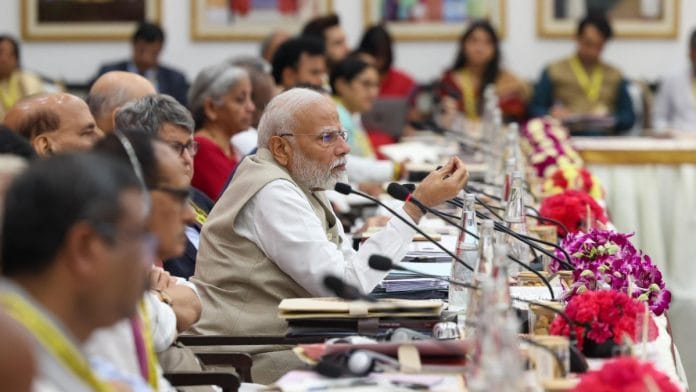New Delhi: The ninth governing council meeting of federal think tank NITI Aayog chaired by Prime Minister Narendra Modi saw chief ministers of 26 states, who attended it, discuss several pressing issues and Modi sharing his thoughts on those issues.
But, in what could be a first, chief ministers of some states raised the issue of “demographic management” and how it should be addressed, NITI Aayog CEO B.V.R. Subrahmanyam said at a press conference here Saturday.
Subrahmanyam, however, refrained from naming the chief ministers who raised this issue, saying instead that “it will be talked about in due course”.
Responding to concerns raised by some chief ministers, Modi, who chaired the governing council meeting, encouraged states to initiate demographic management plans to address the issue of an ageing population in the future.
This could probably be the first time that states and the central government have spoken about the need for a demographic management plan to address India’s ageing population at a formal forum like the governing council meeting.
At the meeting, in which chief ministers of at least 10 states/UTs did not participate, Modi also emphasised cooperation and collective effort on the part of all states and the Centre towards achieving the government’s vision of Viksit Bharat by 2047.
He directed NITI Aayog to prepare an ‘investment-friendly charter’ to attract investments, and also encouraged the creation of river grids at the state-level for effective utilisation of water resources.
“The PM suggested that we must target zero poverty as a priority for a Viksit Bharat. He emphasised that we need to tackle poverty on an individual basis rather than just at a programme level. He observed that removing poverty from the grassroots would bring about a transformational effect in our country,” Subrahmanyam said.
Also Read: India’s fertility rate plunged in last 70 yrs, population to shrink further by 2050 — Lancet study
‘States to see rapid population decline at some point’
Briefing reporters after the governing council meeting, the NITI Aayog CEO said demographic management is about a country actually ageing.
The elderly population in India is rising at an “unprecedented” rate and could surpass the population of those below 15 years of age by mid-century, according to UNFPA’s India Ageing Report 2023. According to it, the share of the elderly (60+ years) population in India is projected to increase from 10.1 percent in 2021 to 15 percent by 2036 and to 20.8 percent by 2050.
Subhrahmanyam said India’s median age today is 28-29. “By 2047, it will be 38-39. The number of older people is going to grow from about 13 crore today to about 35 crore then. But the question is soon after that there will be a rapidly ageing population,” he said.
NFHS data shows that India’s Total Fertility Rate (TFR) has declined significantly — from 6.18 in 1950 to 4.6 in 1980. By 2021, it declined further to 1.91, below the replacement level of fertility of 2.1 children per woman, needed to maintain a stable population size.
TFR is the number of children born to a woman over her childbearing years.
Currently, only five states have a TFR above the replacement level of fertility: Bihar (2.98), Meghalaya (2.91), Uttar Pradesh (2.35), Jharkhand (2.26), and Manipur (2.17).
The NITI Aayog CEO also said some chief ministers talked about how planning to change a declining population at a late stage may not be successful. “… a lot of countries have failed to do that.. Korea, Japan, now China is an example,” he said.
These states, Subrahmanyam said, face the risk of running into declining populations soon.
“This is the first time the thought is being put on the table. Demographic management not population control probably means two things. One, you start planning for looking after an ageing population, it could be economic, social, facilities, infra. Second part of course is how do you address it.
“States will get into a rapid population decline at some point in future… they are not talking of anything in particular but about population problem and it was acknowledged across the room that an old population with a very high median age is a very different society than a society with a very low median age… so, you have to start thinking about it,” he added.
NITI Aayog member Arvind Virmani acknowledged that a number of states will witness a reduction in the share of the working population.
“… Idea of the persons (some chief ministers) mentioning it is because of the demographic change that is happening. This will accelerate in the next 15 years and of course one aspect of that is ageing but the second aspect is in terms of skills, and the jobs, which will be created in the states where young population is declining relatively or in terms of population of working age… it’s all about the working age population. So, that internal dynamics we have to start thinking about…,” he said.
Virmani added that an old population with a very high median age is a very different society than a society with a very low median age. “…So you have to start thinking about it.”
(Edited by Amrtansh Arora)
Also Read: What brings joy to India’s elderly? There’s more to them than RWA, bhajans, ashrams






